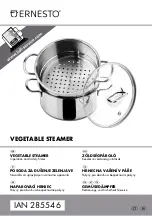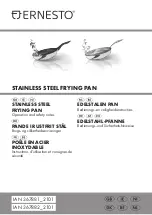
8
ENGLISH
To Clean the Ravioli Maker
Attachment
1. Dust the attachment with flour and
use the cleaning brush to remove
dried dough.
2. Remove the hopper and snap open
the thin white plastic guides/levers at
the bottom of the attachment for easy
access to the rollers. Wash the Ravioli
Maker Attachment in warm soapy
water then rinse with clean water.
NOTE:
To avoid damaging the Ravioli
Maker Attachment:
• Do not wash in dishwasher.
• Do not run a dish towel or any
other cloth through the rollers
to clean them.
• Do not insert objects such as knives,
screwdrivers, etc., to clean the
Ravioli
Maker.
Tips for Exceptional Pasta
• Good pasta dough is firm and leathery
to touch, but also pliable. It should not
stick to your fingers or crumble and fall
apart. Many factors, such as humidity,
brand of flour used, and size of eggs,
may affect dough consistency.
• To test for correct dough consistency,
pinch a small amount of dough
together after mixing with the flat
beater. If the dough stays together
without sticking to your fingers,
it should work well.
• If dough seems too dry, add a small
amount of water to reach the correct
dough consistency. Repeat the folding
and kneading processes.
• If dough seems too wet, add a small
amount of flour to reach the correct
dough consistency. Repeat the folding,
and kneading processes.
Ravioli Maker Attachment
Cooking and Storing Ravioli
away. Boil in 6 qt (5.7 L) salted water
until al dente or slightly firm to the bite,
approximately 3 to 4 minutes.
Separated ravioli can be stored in the
refrigerator overnight. For longer storage,
individually freeze ravioli on a baking sheet.
Then store in the freezer in a sealed container.
Separated ravioli can be cooked right











































